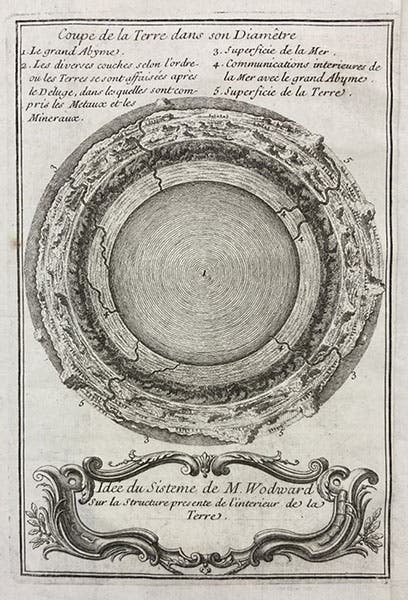Scientist of the Day - John Arbuthnot
John Arbuthnot, a Scottish physician and satirical writer, was baptized Apr. 29, 1667. In the 1690s, hackles were being raised in England by a new kind of scientific discourse known as "Theories of the Earth.” Thomas Burnet had launched the controversy with his Sacred Theory of the Earth (1681-89 in Latin, 1684-90 in English), which maintained that the miracle of the Flood described in Genesis was actually the result of natural process, as the recently formed Earth dried out, cracked open, and let loose a subterranean abyss in the form of Noah’s flood. Burnet was controversial because, in a sense, he took the miraculous out of the account in Genesis, and so critics responded with their own theories of the Earth, and the genre was launched. One of the new theorists was John Woodward, Gresham professor of physic and an expert on fossils. In his An Essay toward a Natural History of the Earth (1695), Woodward put the miracle back into the Flood, but in a wholly novel way – he said that when the rains came, God temporarily suspended gravity, and so waters boiled up out of the deep, and the entire Earth became a thick soup of dissolved rock, water, and living things. When gravity was reestablished, the living things sank according to their density, the soil reformed into rock, and voila, the Earth now had strata with fossils embedded in the rock. Woodward was the first person able to give an account of how fossils might have gained entry into the layers of the Earth's crust. The image of the subterranean waters (below) is from a 1735 French edition of Woodward’s work; earlier editions have no images.
Enter Arbuthnot, at that time a literary and scientific unknown. He didn't know much about fossils (actually, he knew absolutely nothing about fossils), but he knew something about logic and argument, and he felt Woodward had lost track of both when he wrote his book. So Arbuthnot published an Examination of Dr. Woodward's Account of the Deluge (1697), in which he tore Woodward's explanations to shreds. If all that water came out of the Earth's interior at the time of the Earth's dissolution, why didn't it return upon the resumption of gravity and take all the organic matter with it? Why did so many fossils remain on the surface? Why do we find tiny fossils and big heavy fossils together, in spite of Woodward’s assertion that fossils sorted themselves out by density? He also generally made fun of Woodward's pomposity and lack of humility – and Woodward was indeed an arrogant ass much of the time. Woodward probably wasn't too worried by Arbuthnot's attack, since no one knew who Arbuthnot was. But that would change. Arbuthnot was a very personable young man, and a good doctor, and before long he was one of the most distinguished medical men in London and the primary physician to Queen Anne. Moreover, he had learned from the Woodward experience that skewering the fatuous and arrogant could be a most pleasurable activity. In 1712, Arbuthnot organized the Scriblerus Club, a group that included Jonathan Swift and Alexander Pope, and they churned out satirical pamphlets attacking all manner of Augustan pomposity. One of their productions was called the History of John Bull, and it was written mostly by Arbuthnot. In it, they lampooned the long, drawn-out War of the Spanish Succession, and many of the characters are personified countries: John Bull represents England, his sister Peg is Scotland, and France is Louis Baboon (Louis Bourbon). John Bull would prove to me a big hit, and you can find his likeness on World War I and II recruiting posters (third image, below), and in ads right down to the present day. Since Arbuthnot was the only one of the Scriblerians who had any scientific training, it is thought that Arbuthnot provided much of the information about the Royal Society that Swift lampooned so cleverly in Book 3 of Gulliver's Travels (1726). It is notable that of all the Augustan wits, including Pope and Swift, Samuel Johnson thought that Arbuthnot was the wittiest of them all.
Several portraits of Arbuthnot survive, the best being one by Godfrey Kneller, who also gave us our most familiar portrait of Isaac Newton. His Arbuthnot is in the Hunterian Museum in Glasgow, with a copy in the Royal College of Physicians in Edinburgh (first image). And if we might return briefly to Arbuthnot's theory of the Earth, to make a point about book collecting, you might know that the Linda Hall Library has a Special Collection of Theories of the Earth, at last count numbering some 229 titles, making it one of the best such collections in the world, with many of our volumes available online. But we do not have a copy of Arbuthnot's Examination of Dr. Woodward's Account of the Deluge in the collection. We have been looking for one for over 35 years, ever since we organized our exhibition, Theories of the Earth, in 1984, but we have never found a copy for sale. Sometimes, to the despair of every special collections librarian, certain books just never turn up on the market. Dr. William B. Ashworth, Jr., Consultant for the History of Science, Linda Hall Library and Associate Professor emeritus, Department of History, University of Missouri-Kansas City. Comments or corrections are welcome; please direct to ashworthw@umkc.edu.








